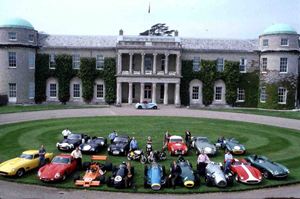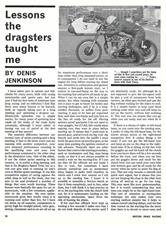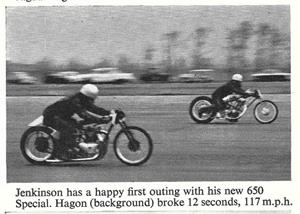
As told exclusively to Denis Sargent Jenkinson was a motorsport enthusiast and journalist who, amongst many other achievements, gained fame as navigator for Stirling Moss in the 1955 Mille Miglia 1000 mile race. He was known as DSJ or “Jenks” to the readers of Motor Sport magazine where he was Continental Correspondent for more than forty years. When the 1964 Dragfests arrived Jenks, already a fan of Sydney Allard’s pioneering efforts to introduce the sport to the UK, not only wrote enthusiastically about the events, but competed himself on his home built NorBSA motorcycle, and driving an Allard Dragon. This article was written by Tony Madgwick of the VMCC Sprint Section who became custodian of two of Jenks' motorcycles, including his 1965 Dragfest bike which he restored himself. Editing, further research and compilation was carried out by Chris Dossett of Trakbytes. Much has been written about Jenks over the years, in particular the book “Jenks: A Passion for Motor Sport”. Tributes were found in magazines such as Motor Sport and Autosport as well as some broadsheets following his death in 1996. A web search entitled “Jenks” on the Motorsport Magazine site reveals an indication of the man and his achievements, and the respect he was held in by those who knew him and his fellow professional writers. However his involvement in Drag Racing tends to be somewhat overlooked, so here is a piece that includes some maybe lesser known motorcycle related tales, unearthed and gathered together by Motorcycle Sprint enthusiast and member of the Vintage Motorcycle Club Sprint Section, Tony Madgwick, who became the custodian and campaigner of Jenks’ TriBSA in 1996, and following Jenks’ passing, custodian, restorer and campaigner of Jenks’ 650 Triumph drag bike from 1965. Jenks’ motorcycling passion began at an early age. In 1946 he was amongst a small group of like-minded motorcyclists who were at the inaugural meeting of the Vintage Motorcycle Club, held at a location on the A31 Hogs Back between Guildford and Farnham. In 1948 he was racing his own Norton on the Continental road racing scene. This lead to a meeting with sidecar rider Eric Oliver who offered the role of ‘ballast’ to Jenks, and in 1949, the year the FIM launched its sidecar world championship, they became world champions. Jenks was a discreet winner. He’d explain: “Eric Oliver was World Champion, I just looked on in wonder!”
After his passengering activities with Eric, Jenks also passengered (its thought for two years at least) for the Belgian rider Marcel Masuy. In 1955, when Marcel subsequently crashed fatally in a race at Senigallia, Italy, Jenks told his friend and motor racing historian Doug Nye that the blame was attached to his then passenger, who had “stepped off and abandoned him” when Masuy began to lose control. 1955 saw Jenks team up with Stirling Moss, for the Mille Miglia 1000 mile road race for four-wheelers. They drove the circuit before the race with Jenks making notes relating to the speeds that each and every corner, hump back bridge etc in each section could be driven. This was transcribed to a 17ft roll of paper and fitted into an aluminium box with viewing window (the bog roll). By the use of pre-determined hand signals (as 150mph in an open top car was a tad too noisy for verbal communication), they won the race, the first time in 22 years by a British driver. Jenks’ write up in June 1955’s Motor Sport was over 7½ pages and is still a highly regarded piece of motoring journalism, and the “bog roll” is what we now call “Pace Notes”. Stirling Moss was knighted for his services to motor racing in 2000.
Motorcycle sprinting had been around for a long while, with the National Sprint Association forming in 1958, and was generally a ¼ mile straight line dash, one rider at a time, with the times determining the results. Jenks had been competing at various events, including Brighton’s Speed Trials, on his 500cc NorBSA, so was familiar with the straight line concept. Car sprinting on the other hand was often on twisty tracks and hill climbs where corner handling was a key component, so the car’s set up was a compromise. Blackbushe was just up the road from Jenks’ little lodge home and workshop, located between Crondall and Odiham in Hampshire. Jenks rode his NorBSA at the 1964 Dragfest. but he was fortunate enough to also drive an Allard Dragon belonging to Gerry Belton, and to the best of my knowledge, was the only person to both ride and drive at the inaugural event. He then wrote a Dragfest review of over 3 pages in the November ‘64 issue of Motor Sport, along with a personal (riding/driving) piece as Continental Correspondent, which included a photograph of his motorcycle with front wheel off the ground, thus bringing this new form of motor sport to a relatively wide audience of motor racing enthusiasts.
Drag racing had arrived, and in 1965 a new magazine was launched called Drag Racing, and the number 2 issue (April 65) included a photo on the cover of Jenks on his NorBSA at Blackbushe in 1964 with the front wheel airborne. In addition to the 1964 Dragfest, Jenks had ridden a hill-climb motorcycle at various events including Oddicombe in Devon, Shelsley Walsh and, its thought, also at Wiscombe Park. (There’s a photo book of Shelsley Walsh, all the photos are of cars bar two, one of John Surtees on a Vincent, the other is Jenks on his TriBSA). By the time the 1965 Dragfest arrived Jenks had decided a more ‘suitable’ bike was needed over his sit-up-and-beg, road-based NorBSA, and he put together a long, light and low 650cc Triumph powered machine, fuelled with methanol via a weber. The frame had a top tube for fuel, a spine tube for oil, Velocette LE forks and a racing sidecar tyre for a square profile/footprint, all built to suit the 5’ 2” Jenks. After the event he again penned many a page in Motor Sport magazine.
1966 saw the opening of Santa Pod, and it’s fair to say, we had properly entered the age of drag racing on this side of the pond. When writing for Motor Sport magazine Jenks often reported on high performance road cars (by driving them) as well as Grand Prix racing, and decided to take a fully-fledged race car on his test route, until then reserved for road cars, around the roads of Hampshire. A quiet day was chosen (Christmas day) and a Formula 2 Lotus was supplied by Colin Chapman. So off he went, however, the book Jenks: A Passion for Motor Sport reports the test ended early after a mechanical breakage... In the mid ‘70’s, as best can tell, the 650 Triumph drag bike ‘donated’ its power plant into a modified BSA A7/A10 frame and the bike became Jenks’ TriBSA Hillclimb special, along with a slim FS1E petrol tank. In 1990 the 12th of August saw Jenks competing at Shelsley Walsh hill-climb, where he successfully managed to achieve his best ever run, a sub 40 second 39.75. At Colerne in 1993 each of his three runs got quicker, and he told his good friend Mick Wilkins “If I die tonight, I’ll die a happy man”. Mick became a good friend of mine after Jenks passing.
Regarding the Goodwood Festival of Speed appearance, Doug Nye (Jenks’ friend and motor racing historian) tells the story: “I was one of the event co-founders and organisers and we ran a motor-cycle class for riders over 70 years of age, hopefully so that DSJ could win it. The silly bugger was beaten by a very well-known rider who was in his late 80s, or even early 90s whose name I cannot now recall… was it Arthur someone? Very well known amongst vintage motorcycle circles at the time in any case. Jenks himself thought that was hilarious (typically). Vincent rider Chas Guy was tragically killed in that first Goodwood FoS, up beyond the finish line when he got into what John Surtees described as the classical Vincent tank slapper, stayed on the power, and ran off into the trees there… Very sad.” After suffering a stroke in January 1996 Jenks lived out his last months at the British Motor Industry (BEN) nursing home, Lynwood, in Sunninghill near Ascot. There were many tributes paid, including those in Motor Sport magazine where he wrote as Continental Correspondent for decades, as well as Autosport and many broad sheet newspapers. Doug Nye and his photographer friend Geoff Goddard were appointed to be his executors, and they organised the funeral which was held at the Aldershot crematorium and attended by, amongst others, Stirling Moss, Tony Brooks, Patrick Head of Williams and Frank Dernie of Arrows. The ceremony was conducted by Canon Lionel Webber (chaplain to the Queen and The British Racing Drivers Club). The chapel was packed, and the car park was something to behold. Back to Tony from the VMCC Sprint Section. I had become custodian of the TriBSA shortly before Jenks’ passing, and a short time later the rolling chassis of the ’65 Dragfest bike, which I later re-built with a period correct 650cc Triumph power plant to match the original. I was fortunate enough to compete at Shelsley Walsh on the TriBSA, and ensured a nod to Jenks as the bike ran the hill one more time. I also ran it at the Brighton Speed Trials, an event organised and run by the Brighton and Hove Motor Club, who kindly invited the VMCC Sprint Section to run the bikes, and where I also ran the recently restored ’65 Dragfest Triumph which, along with the TriBSA, was recognised by a fair few enthusiasts.
The 1997 Goodwood Festival of Speed had a Jenks marquee to commemorate the man, and a display area where many of his machines were exhibited. I took the TriBSA. However, ‘red tape’ prevented the planned ‘two minutes noise’ (for, I believe, the whole site to observe) from happening. One bike had a little step ladder by it, reflecting the height of Jenks. I made many friends and gained a deeper insight into DSJ.
New custodians were found for the hill-climb bike and drag bike at the Goodwood Festival of Speed in 2004. Jenks domestic life is summed up nicely by Doug Nye. "He lived in his little lodge house literally ‘off-grid’ with no mains electricity, and water delivered by over a mile of 3/4-inch garden hose run across the fields from the nearest neighbouring farmhouse. His living room had long since been devoted to use as a workshop, crammed with parts of bikes, cars, and trailers. There were masses of tools, tubs of nuts, screws, washers, bolts, tie wraps, bits of old wire and more and more. The cottage itself was flanked by rows of self-made wooden garages and storage sheds. These were nailed together by DSJ from the resinous wood he salvaged from Honda motor-cycle packing cases, which were supplied to him buckshee by his friend Ken Heanes, who ran the local motorcycle agency in Fleet, and incidentally prepared the Triumph motorcycles used in The Great Escape." Sir Stirling Moss had described Jenks as the most famous person in motor sport not to have driven a car, and, shortly after his death, made a toast to Jenks saying “He was a wonderful bloke, and without doubt one of the true eccentrics”. After re-reading Jenks: A Passion for Motor Sport and listening to stories from an old pal of Jenks, this fellow with only one pair of socks (one blue, one pink) who had a small step ladder to get on one of his bikes, well, one has to smile. Tony Madgwick (VMCC Sprint Section) with acknowledgements to Doug Nye. P.S. One of Jenks's kitchen-wall scribblings in his little lodge house in Crondall read "Aah nostalgia. The Real Thing".
Programme and magazine scans: click thumbnail to enlarge, click back to return.
Gallery: click on any thumbnail for a large image.
Back to pioneers index Back to News page |





















































